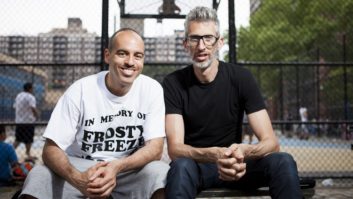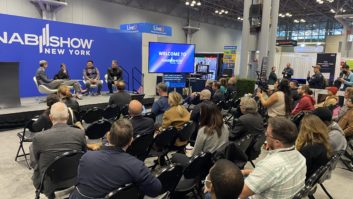John Battison’s 1998 NAB Engineer of the Year Acceptance Speech
Nov 1, 2009 12:00 PM
Through John Battison’s Eyes
In 1998, John Battison was awarded NAB’s Engineer of the Year Award for radio. To know John is to know the history of our industry, and to hear him speak is an education in itself. The acceptance speech he delivered to accept the NAB award outlines part of John’s amazing career and illustrates perfectly to the industry’s relative newcomers just how far we’ve come. A transcript follows.
In addition, in 2006, John was awarded the Society of Broadcast Engineers Lifetime Achievement Award. John is the founder of the SBE.
Good afternoon NAB, fellow engineers, ladies and gentlemen. Thank you National Association of Broadcasters and my sponsor for this honor. I’m very proud to receive it. I finally retired this spring, and it’s 1000dB nicer than a gold watch.
Looking back over 52 years of broadcast engineering, I want to thank all the people who have helped me. Among these are Frank Marx, who hired me in the ABC Engineering Department, and especially Carl Smith, who has been a very good friend for most of my engineering life, as well as a fine employer.
Television came to life when ABC received its TV CPs, and we had to find a TV studio site in New York. We decided on the old riding stables just off Central Park. Then we had to get rid of the birds and the horse’s souvenirs.
We had hoped to put the WJZ-TV transmitter on the RCA building. In the interim, we put it on the Pierre Hotel and got a horrendous ghost on Westchester County.
I met most of the famous engineers who made US radio what it is today, and many of the pioneer radio inventors including Lee de Forest and Major Armstrong, the inventor of FM. I built an Armstrong Super Regenerative receiver in the 1920s, so of course I already knew his name. When I met him, he was �Major FM.�
As time passed, AM became �ancient modulation� and FM became the �forgotten medium.� Eventually, FM took hold and we engineers pretty well filled up the New England area with FM stations.
In 1961, in a Broadcast Engineering magazine editorial, I urged the creation of a broadcast engineering society. I received lots of support. In 1963, I personally wrote to every radio and TV chief engineer � about 6,000 letters � proposing that we start one.
In 1964, NAB gave us space in the Chicago Convention; about 100 engineers turned up. I was made steering committee chairman, and the Society of Broadcast Engineers was formed. We published a quarterly SBE journal with a lot of member input. We had great industry support and led off with a greeting from the FCC chairman.
In 1965, I was elected president. We had about 400 members and eight chapters around the country. I handed [the reigns] over to Charlie Hallinan as president in 1966, and the SBE never looked back.
Also in the sixties we had the �10% Rule,� which allowed us to build new AMs – provided there was not more than 10% interference! Finally, the FCC imposed an AM freeze to undo the mess that AM was in.
Then there was a burst of activity from the daytimers, and Ray Livesy headed up another attack on the FCC to liberalize night operation. This resulted in some strange night powers ranging from about six Watts to several hundred. Many small towns received some level of new, local night radio service.
Sometime during this period, AM stereo came � and went � mainly through FCC vacillation. By the way, I liked Leonard Kahn’s system best.
The US participated in the Region Two World Administrative Radio Conference in Buenos Aires in 1980, and I was honored to be a member of the FCC/Industry team. We went down to the conference with strict orders from the FCC to plug for nine kc AM separation.
— continued on page 2
John Battison’s 1998 NAB Engineer of the Year Acceptance Speech
Nov 1, 2009 12:00 PM
Through John Battison’s Eyes
The reason given was compliance with the official Region Two channel spacing and to make room for more AM stations. Another argument was to avoid one kc heterodynes from increasingly powerful AM stations in Europe and the emerging nations. Actually, there were very few �whistles.�
After being in Buenos Aires for about four days, we had succeeded in persuading many other delegations from the Americas that the change was good. Then we suddenly received orders from the FCC to forget nine kc separation! With rather red faces, we had to change horses in midstream and persuade them to switch back to 10kc.
The FCC introduced the �standard� antenna pattern. It replaced the old MEOV that was the consulting engineers lifeboat when a pattern wouldn’t come in.
The end of the eighties saw LPTV come into bloom and CPs were issued by the hundreds — but not all were built.
By this time, engineers in radio stations were a thing of the past. �Five-week wonder� First Class Licenses made DJs into engineers, and remote control took over many of the operations. Automated transmitter operation and reduced FCC logging requirements were introduced, and only high-power and directional AMs had to make log readings every three hours.
I wonder how many remember the days of logging transmitter readings every half hour? Or logging base currents daily? It’s quite different today.
So different, in fact, that we don’t need licensed operators any more. Unfortunately, the pirate broadcasters think they don’t need licenses either!
The AM band has been expanded to 1710 kc and a few new stations and a few new stations are on the air.
We’ve advanced from the Conelrad system, through EBS to EAS. This still has problems, but no doubt, eventually, it will work as planned.
Perhaps the greatest change has been the introduction of a piece of rare metal contaminated with an exotic oxide — I’m referring, of course, to the transistor. This little device has changed radio engineering. First came transistor radios plugged into the world’s ears. Then came its big brother — the transmitting transistor. Transmitter manufacturers switched from tubes to transistors as fast as new methods of RF power generation were developed.
The old, single-modulated channel, Class A, triode AM transmitter has developed into multi-channel units like its FM brother. Satellites are offering direct multi program sources and the days of the crystal receiver and headphones are numbered!
When the digital revolution hit radio, its amazing versatility spawned new transmission methods. Almost every day we hear of new ones.
Spread spectrum, once top secret, has given us legally unlicensed STL operation with low power and low costs.
I haven’t even touched on Eureka, DAB, RBDS, cell phones, PCS, GPS, wireless services and the dozens of things still to come.
Radio engineering’s advances from 1945 through 1998 have been fantastic. Someone will say, �He’s forgotten � whatever.� I apologize. Too many things have happened to cover them all.
Speaking as an RF engineer, I still maintain: �Audio is something that messes up a nice, clean carrier.�
NAB, fellow engineers and ladies and gentlemen — I thank you.
Radio Mag Online Podcast for November 2009
The Radio Mag Online podcast for November 2009: John Battison comments on the creation of the Society of Broadcast Engineers while accepting the SBE’s Lifetime Achievement Award in April 2006….











